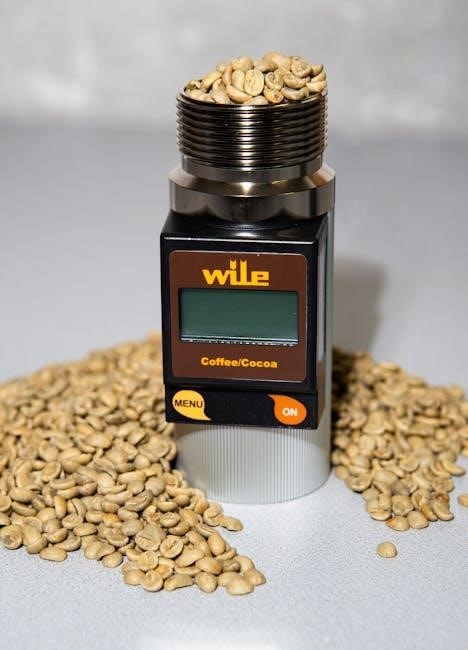
Nissan K25 LPG Forklift Throttle Position Sensor Calibration: An Overview
The Nissan K25 LPG forklift relies on a properly calibrated Throttle Position Sensor (TPS) for optimal engine performance. This guide provides clear calibration instructions, ensuring the engine control unit (ECU) receives accurate data.
Understanding the Throttle Position Sensor (TPS) in K25 LPG Engines
The Throttle Position Sensor (TPS) is a critical component within Nissan K25 LPG engines, essential for monitoring the throttle valve’s position. This information is relayed to the Engine Control Unit (ECU), enabling it to manage fuel mixture and ignition timing accurately. The K25 engine, found in forklifts from brands like CAT, Mitsubishi, Nissan, and Komatsu, utilizes the TPS to ensure smooth engine operation and responsiveness. Proper TPS function is directly tied to the engine’s ability to react efficiently to throttle inputs, impacting overall performance and fuel consumption. Understanding the TPS’s role is the first step in maintaining optimal forklift operation.
Importance of TPS Calibration for Optimal Performance and Fuel Efficiency
Proper calibration of the Throttle Position Sensor (TPS) in Nissan K25 LPG engines is paramount for achieving optimal performance and maximizing fuel efficiency. The TPS informs the Engine Control Unit (ECU) about the precise position of the throttle valve. Accurate data from a well-calibrated TPS allows the ECU to determine the correct fuel mixture and ignition timing, ensuring efficient combustion. When the TPS is miscalibrated, the engine may experience reduced power, increased fuel consumption, and rough idling. Regular TPS checks during maintenance can prevent operational issues and guarantee the forklift operates smoothly, reducing wear and tear on the engine.
Tools Required for Nissan K25 LPG TPS Calibration
To calibrate the TPS, you will need a multimeter for DC voltage measurements, appropriately sized Phillips and flathead screwdrivers, and, depending on the specific TPS design, potentially a wiring diagram.
Multimeter (DC Voltage Measurement)
A multimeter capable of measuring DC voltage is crucial for Nissan K25 LPG TPS calibration. It allows precise measurement of the sensor’s output voltage, typically to a precision of 0.1V. The multimeter helps determine if the TPS signal is within the correct range, indicating proper function. Accurate voltage readings are essential for setting the throttle valve closed position. Without a multimeter, diagnosing and calibrating the TPS becomes nearly impossible, affecting fuel efficiency and engine responsiveness. Ensuring the multimeter is functioning correctly is vital for obtaining reliable calibration data.
Screwdrivers (Phillips and Flathead)
A set of appropriately sized screwdrivers, including both Phillips and flathead types, are essential for accessing and adjusting the Nissan K25 LPG forklift’s Throttle Position Sensor (TPS). The specific type of screwdriver required will depend on the TPS design and the fasteners used to secure it. Having both types ensures compatibility with different models. These tools are necessary to loosen or tighten screws during the calibration process. Without the correct screwdrivers, attempting to adjust the TPS can lead to damaged components or stripped screws, hindering the calibration and potentially damaging the sensor.
Wiring Diagram (Potentially)
A wiring diagram, while not always absolutely necessary, can be a valuable asset when calibrating the Throttle Position Sensor (TPS) on a Nissan K25 LPG forklift. It provides a visual representation of the TPS circuit, helping to identify the correct wires for testing and adjustment. This is particularly useful if you encounter any issues or need to troubleshoot the sensor’s connections. The diagram clarifies the wiring configuration, preventing accidental disconnections or incorrect adjustments. A wiring diagram can save time and reduce the risk of errors.

Step-by-Step Calibration Instructions for Nissan K25 LPG TPS
To calibrate the Throttle Position Sensor (TPS) on your Nissan K25 LPG forklift, begin by locating the TPS. Then, use a multimeter to measure the output voltage at idle. Adjust the TPS until the voltage falls within the manufacturer’s specified range. Next, slowly open the throttle and monitor the voltage, ensuring it increases smoothly without any gaps. Once the throttle is fully open, verify that the voltage reaches the maximum value. Secure the TPS in its calibrated position. This process ensures the engine control unit (ECU) receives accurate data, optimizing engine performance and fuel efficiency.
Troubleshooting TPS Signal Circuit Malfunctions
TPS signal malfunctions include low voltage (open circuit), high voltage (shorted circuit), and excessively low throttle valve closed position learning value. These issues can hinder engine performance and require prompt attention.
Low Voltage (Open Circuit)
A low voltage reading, or an open circuit, from the TPS indicates a break in the electrical connection. This means the signal from the sensor isn’t reaching the ECU. The output voltage will be approximately 0.3V or less for a predetermined period. Check the wiring harness for damaged or corroded wires. Inspect the connector for proper seating and clean contacts. A faulty TPS can also cause this issue. Use a multimeter to verify continuity and voltage levels to pinpoint the source. Repair any breaks or replace the TPS if necessary.
High Voltage (Shorted Circuit)
A high voltage reading from the TPS, indicative of a shorted circuit, suggests an unintended electrical connection. Specifically, the throttle position sensor 2 output voltage has been approximately 4.8V or more for a predetermined period. This can occur when the TPS signal wire is contacting a voltage source. Carefully inspect the wiring harness for any signs of damage, melted insulation, or exposed wires. Check the TPS connector for corrosion or bent pins. Use a multimeter to test for shorts between the signal wire and other circuits. Repair or replace the damaged wiring or connector.
Excessively Low Throttle Valve Closed Position Learning Value
An excessively low throttle valve closed position learning value signifies the ECU is not properly recognizing the closed throttle position. This can happen when the throttle valve closed position learning value is excessively low, leading to issues. This often results from mechanical problems within the throttle body or incorrect TPS adjustment. Begin by verifying the throttle linkage moves freely and isn’t binding. Clean the throttle body to remove carbon buildup that may impede proper closure. If these steps fail to correct the issue, re-calibrate the TPS, ensuring it’s properly aligned with the closed throttle position.
Common Issues and Error Codes Related to TPS
Several issues and error codes can arise from a malfunctioning or miscalibrated TPS on a Nissan K25 LPG forklift. These include poor engine performance, hesitation during acceleration, and increased fuel consumption. Common error codes may point to signal circuit malfunctions, such as an open or shorted circuit. An excessively low throttle valve closed position learning value can also trigger error codes. Diagnosing these issues requires a multimeter to check the TPS output voltage. Always refer to the forklift’s service manual for specific error code interpretations and troubleshooting steps to ensure accurate diagnosis.

Maintenance Checks to Avoid Operational Issues
Regular maintenance checks are crucial for preventing operational issues related to the Throttle Position Sensor (TPS) on Nissan K25 LPG forklifts. These checks should include visually inspecting the TPS wiring and connections for damage or corrosion. Use a multimeter to verify the TPS output voltage is within the specified range at idle and full throttle positions. Periodically check the throttle linkage for proper movement and ensure it isn’t binding or sticking. Address any issues promptly to prevent further damage and maintain optimal engine performance. Remember to consult the service manual for recommended maintenance intervals and procedures.

Alternative Methods for TPS Reset
If standard calibration fails, try alternative methods. Disconnecting the battery’s negative cable or removing the engine control module fuse can reset the TPS. Always consult the service manual before proceeding.
Battery Disconnection
One of the simplest methods for attempting a TPS reset on a Nissan K25 LPG forklift involves disconnecting the negative battery cable. This process deprives the ECU of power, potentially clearing stored values and prompting a recalibration upon reconnection. Ensure the engine is off and the forklift is in a safe, stationary position. Disconnect the negative terminal and wait for approximately five minutes. Reconnect the cable securely. Start the engine and observe if performance improves. This method is a basic troubleshooting step and might not always resolve the issue. Consult a professional if problems persist.
Fuse Removal
Another alternative method for attempting a TPS reset involves removing the fuse associated with the engine control module (ECU). Consult the forklift’s manual to identify the correct fuse. With the engine off, carefully remove the designated fuse for a few minutes. This action, similar to battery disconnection, cuts power to the ECU, potentially clearing any learned throttle position values. After a brief period, reinsert the fuse securely. Start the engine and check for any improvements in engine performance. Like battery disconnection, this method is not guaranteed to resolve all TPS-related issues and further diagnosis may be needed.

Estimated Costs for Professional TPS Calibration
Professional TPS calibration costs vary. Smaller repair shops may charge $100-$150. Dealership services typically cost around $200. These prices reflect labor and potential diagnostic fees involved in accurate calibration.
Smaller Repair Shops
Opting for smaller repair shops for Nissan K25 LPG forklift TPS calibration can offer a more budget-friendly solution. Typically, these establishments provide a more personalized service. Estimated costs range from $100 to $150, encompassing the calibration process and potential minor diagnostic checks. These shops may use aftermarket or OEM parts based on your preference. In contrast to dealerships, smaller shops might have quicker turnaround times and flexible scheduling. Always ensure the shop has experience with LPG systems and forklift-specific repairs before entrusting them with the calibration;
Dealership Services
Choosing a dealership for your Nissan K25 LPG forklift TPS calibration typically involves a higher cost, averaging around $200. Dealerships offer specialized expertise and factory-trained technicians. They use genuine Nissan parts, ensuring optimal compatibility and reliability. Dealership services often include comprehensive diagnostic assessments and software updates. While the cost is higher, dealerships provide a warranty on their services, offering added peace of mind. Expect longer lead times due to higher service demand. Dealerships guarantee the highest standards of service and specialized knowledge for your forklift.